文学翻译unit 5《修辞格的翻译方法》
- 格式:doc
- 大小:62.00 KB
- 文档页数:5
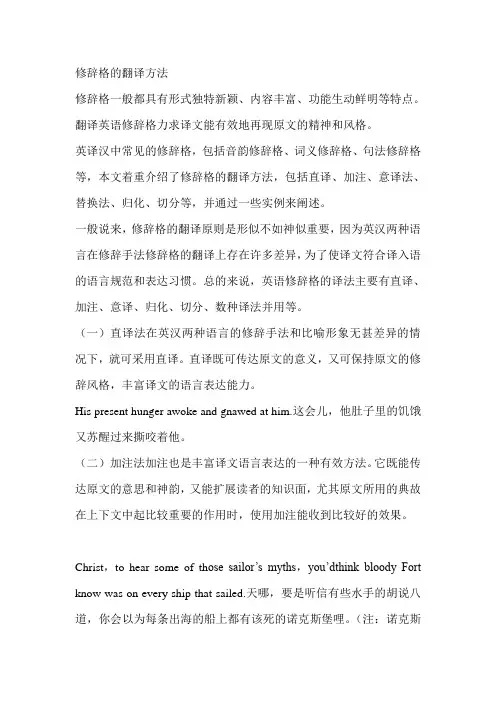
修辞格的翻译方法修辞格一般都具有形式独特新颖、内容丰富、功能生动鲜明等特点。
翻译英语修辞格力求译文能有效地再现原文的精神和风格。
英译汉中常见的修辞格,包括音韵修辞格、词义修辞格、句法修辞格等,本文着重介绍了修辞格的翻译方法,包括直译、加注、意译法、替换法、归化、切分等,并通过一些实例来阐述。
一般说来,修辞格的翻译原则是形似不如神似重要,因为英汉两种语言在修辞手法修辞格的翻译上存在许多差异,为了使译文符合译入语的语言规范和表达习惯。
总的来说,英语修辞格的译法主要有直译、加注、意译、归化、切分、数种译法并用等。
(一)直译法在英汉两种语言的修辞手法和比喻形象无甚差异的情况下,就可采用直译。
直译既可传达原文的意义,又可保持原文的修辞风格,丰富译文的语言表达能力。
His present hunger awoke and gnawed at him.这会儿,他肚子里的饥饿又苏醒过来撕咬着他。
(二)加注法加注也是丰富译文语言表达的一种有效方法。
它既能传达原文的意思和神韵,又能扩展读者的知识面,尤其原文所用的典故在上下文中起比较重要的作用时,使用加注能收到比较好的效果。
Christ,to hear some of th ose sailor’s myths,you’dthink bloody Fort know was on every ship that sailed.天哪,要是听信有些水手的胡说八道,你会以为每条出海的船上都有该死的诺克斯堡哩。
(注:诺克斯堡是美国一个军事保留地,是美国黄金仓库的所在地。
)(三)意译法由于许多英语修辞手法或比喻形象本身是特有的,如保留其形象就会危害其义。
如英语的头韵法,其搭配可以千变万化,很难碰巧找到这样的汉语搭配,即使勉强凑韵,也不一定能表达原文的意思。
在这种情况下,必须首先保证译文能正确传达原文的思想内容,然后尽一切可能去表现原文的节奏和旋律。
safe and sound安然无恙now and never机不可失(1)He is the mouth of the House in its relations with the crown.他是议会对王室的发言人。
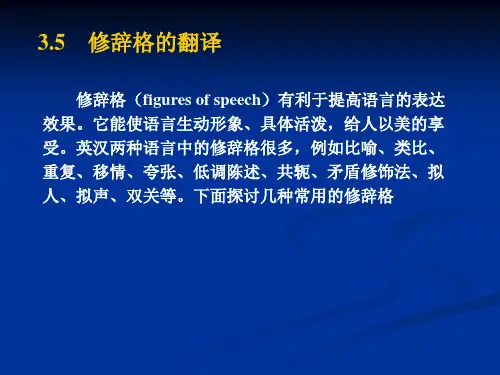
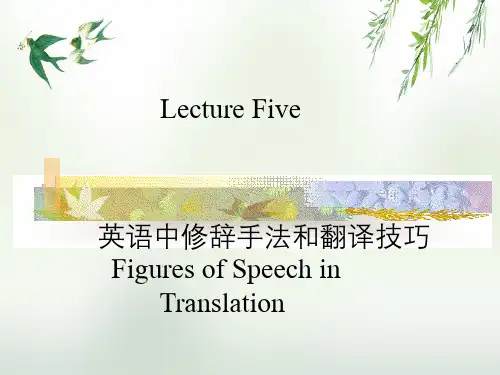

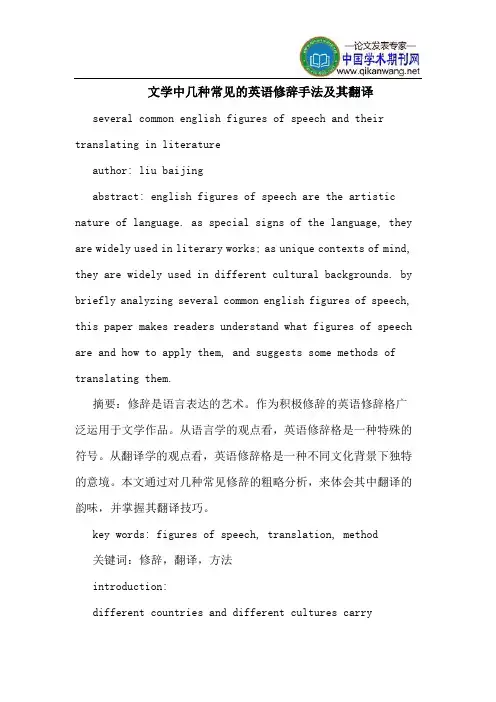
文学中几种常见的英语修辞手法及其翻译several common english figures of speech and their translating in literatureauthor: liu baijingabstract: english figures of speech are the artistic nature of language. as special signs of the language, they are widely used in literary works; as unique contexts of mind, they are widely used in different cultural backgrounds. by briefly analyzing several common english figures of speech, this paper makes readers understand what figures of speech are and how to apply them, and suggests some methods of translating them.摘要:修辞是语言表达的艺术。
作为积极修辞的英语修辞格广泛运用于文学作品。
从语言学的观点看,英语修辞格是一种特殊的符号。
从翻译学的观点看,英语修辞格是一种不同文化背景下独特的意境。
本文通过对几种常见修辞的粗略分析,来体会其中翻译的韵味,并掌握其翻译技巧。
key words: figures of speech, translation, method关键词:修辞,翻译,方法introduction:different countries and different cultures carrydifferent histories, but it makes us get together at the same time. language is a tool for people to convey their feelings and thoughts. in order to improve the effects of expression and strengthen the persuasion, people apply many varieties of methods. m.a.k halliday said: “each language has its own logic, own figures of speech, and own value of aesthetics.”so we find, figures of speech are the artistic nature of language.as special signs of the language, figures of speech are widely used in literary works; as unique contexts of mind, they are widely used in different cultural backgrounds. the categories of english figures of speech (feng cuihua. english figures of speech): simile, metaphor, analogy, personification, hyperbole, understatement, euphemism, metonymy, synecdoche, antonomasia, pun, zeugma, irony, innuendo, sarcasm, paradox, oxymoron, antithesis, epigram, climax, anti-climax, apostrophe, transferred-epithet, alliteration, onomatopoeia, and repetition.the charm of figures of speech in literature lies in its beauty of relation, beauty of change, beauty of harmony, and beauty of sound and color. now, let us analyze several commonenglish figures of speech in literature, and try to summarize the methods of translating them.1. simileit is a figure of speech, which makes a comparison between two unlike elements having at least one quality or characteristic in common. to make the comparison words like as ,as…as, as if, and like are used to transfer the quality we associate with one to the other.e.g. ①sore-eyed children clouds cluster of everywhere in unbelievable numbers, like clouds of flies.(“marrakech” ae1) 眼睛红肿的孩子随处可见,多的像一群群的苍蝇,数也数不清。

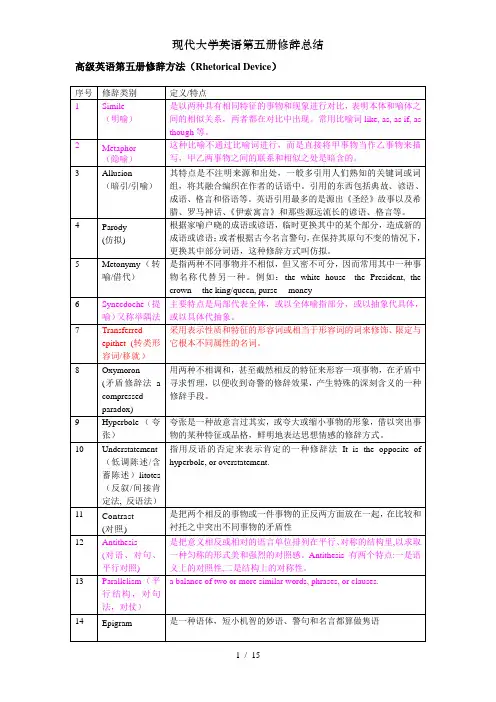
高级英语第五册修辞方法(Rhetorical Device)1. Simile:L1-17: It is something like… behind bars.L1-25: Let us be dissatisfied until from every city hall… a mighty stream.(justice will roll down like waters and righteousness like a mighty stream)L5-5: Same age, same background, but dumb as an ox. (dumb as an ox)L5-50: First he looked at the coat with the expression of a waif at a bakery window. (comparing his longing for the raccoon coat with the expression of a hungry homeless child looking longingly at the bread at a bakery window.)L5-123: It was like digging a tunnel. (comparing his teaching to the hard work of digging a tunnel.)L5-147: I leaped to my feet, bellowing like a bull. (comparing his angry shouts to the bellowing ofa bull)L7-2: …united with others of our country in everything…like the fingers of the hand.(comparing the relationship between black and white to fingers of the hand)L7-10: Yet even then I had been going over my speech...as bright as flame. (comparing each word of his speech to bright flame)L7-16: For in those days I was what they called ginger—colored...like a crisp ginger cookie.(comparing the narrator to a cookie)L7-20: My saliva became like hot bitter glue.L7-21: The boys groped about like blind, cautious crabs... hypersensitive snails. (comparing the black boys to animals)L7-27: A blow to my head as I danced about sent my right eye popping... my dilemma.L7-45: I roiled away as a fumbled football rolls off the receiver’s fingertips...L7-46: 1 was limp as a dish rag.2. Metaphor:L1-5: Psychological freedom. . . physical slavery. (the long night of physical slavery)L1-5: The Negro. . . his own emancipation proclamation. (“signs with the pen and ink of assertive manhood his own emancipation proclamation”)L1-14: … when the unjust… is eliminated. (measurement, a scale of dollars)L1-20: He who hates… ultimate reality. (owning a key to open a door)L1-25: the battering rams of the forces of justice;the junk heaps of historyLet us be dissatisfied until the tragic walls… the forces of justice. (“the tragic walls” and “the battering rams”)L1-27: When our days…into bright tomorrow. (low-hovering clouds of despair; gigantic mountains of evil)L4-3: Killing the Angel in the HouseL4-5: The image of a fishermanL4-7: A room of one’s ownL5-1: There follows an informal essay that ventures even beyond Lamb’s frontier. (comparing the limitation set by Lamb to a frontier)L5-20: My brain, that precision instrument, slipped into high gear. (Mixed metaphor, comparing at the same time the narrator’s brain to a precision instrument and also to a machine that has gears.)L5-34: In other words, if you were out of the picture, the field would be open. (comparing the competing for friendship to an athletic event)L5-98: Maybe somehow I could fan them into flame. Maybe somewhere in the extinct crater of her mind, a few embers still smoldered. (comparing Polly’s mind to the extinct crater of a volcano)L5-115: Poisoning the well: (comparing “the personal attack on a person holding some thesis” to “poisoning the well”)L5-151: The rat. (comparing Petey to a rat)L6-41: I’ve never met anyone… the second time around. (The metaphor of record player is used.)3. Allusion:L1-25: Let us be dissatisfied until that day… none shall be afraid. (a biblical allusion: the 1ion and the lamb shall lie down together; every man will sit under his own vine and fig tree and none shall be afraid)L5-64: We went to the Knoll, the campus trysting place, and we sat down under an old oak… (An implied allusion to Robin Hood, whose trysting place was under a huge oak tree in Sherwood Forest.)L5-138: I was not Pygmalion; I was Frankenstein, and my monster had me by the throat.L10-8: Overnight… surreal episodes…(a sword of Damocles)4. Parody:L10-25: Is our democracy… of liberty? (This is a parody of a line in Patrick Henry’s speech: “Is life so dear or peace so sweet, as to be purchased at the price of chains and slavery?”)5. Metonymy:L4-1: No demand was made upon the family purse. (“purse” stands for money)L4-2: But to show you how little I deserve to be called a professional woman…with my neighbors. (Butcher’s bills stand for meat bought from a butcher. )L5-23: She was, to be sure, a girl who excited the emotions. But 1 was not one to let my heart rule my head. (to let my heart rule my head: Metonymy. “Heart”stands for “feelings and emotions” and “head” for “reason and good sense”.)L5-105: …surgeons have X-rays to guide them during an operation. (X-rays stand for X-rays photographs)L10-2: Anthrax panic… chambers (“Congress” stands for its members)6. Synecdoche:L1-25: Let us be dissatisfied until from every city hall… a mighty stream.city hall (the naming of a part to mean the whole. Here, the naming of the building for the government)L4-2: But to show you how little I deserve to be called a professional woman…with my neighbors. (bread and butter: This set phrase means food and the most important and basic things. )7. Transferred epithet:L1-25: Let us be dissatisfied until the tragic walls… the forces of justice. (the tragic walls)L5-40: I said with a mysterious wink… (the wink was not mysterious)L7-6: our bare upper bodies touching and shining with anticipatory sweat (In “anticipatory sweat”, the adjective “anticipatory “ is a transferred epithet.)L7-25: He kept coming, bringing the rank sharp violence of stale sweat. (the rank sharp violence: Logically rank and sharp modify “stale sweat”, not “violence”.)8. Oxymoron:9. Hyperbole:L5-5: It is not often that one so young has such a giant intellect. (exaggerating for effect)L5-50: … he just stood and stared with mad lust at the coat. (It’s an exaggeration to describe his longing for the coat as “mad lust”)L5-135: You are the whole world to me, and the moon and the stars and the constellations of outer space.L5-135: I will wander the face of the earth, a shambling, hollow-eyed hulk.10. Understatement or litotes:L5-61: This loomed as a project of no small dimensions, and at first 1 was tempted to give her back to Petey. (no small dimensions)11. Contrast:L3-22: A contrast is made between old Shanghai and Shanghai in the 1990s.L8-3: While Oppenheimer was interrupting…. had invented the subject. (an implied contrast)L10-25: How do we… poise? (paranoia vs. poise)12. Antithesis:L1-5: As long as. . . can never be free. (mind vs. body, enslaved vs. free)L1-5: Psychological freedom. . . physical slavery. (psychological freedom vs. physical slavery)L1-7: …love is identified… denial of love (1ove vs. power, a resignation of power vs. denial of love)L1-19: For through violence… but you can’t murder hate. (You may murder a murderer but you can’t murder murder.)L1-25: outer city of wealth and comfort vs. inner city of poverty and despair;wealth vs. poverty (economic);comfort vs. despair(mood, psychology)dark yesterdays vs. bright tomorrows;segregated schools vs. integrated educationon the basis of the content of their character vs. on the basis of the color of their skincontent(substance) vs. color (superficial)character(fundamental) vs. skin (outward appearance)L1-27: When our days…into bright tomorrow.dark yesterday VS. bright tomorrowL5-27: It is, after all, easier to make a beautiful dumb girl smart than to make an ugly smart girl beautiful.beautiful dumb vs. ugly smartL5-50: Back and forth his head swiveled, desire waxing, resolution waning.Desire waxing vs. resolution waningL5-153: Look at me—a brilliant student, a tremendous intellectual, a man with an assured future.Look at Petey—a knot-head, a jitterbug, a guy who’ll never know where his next meal is coming from.Brilliant, intellectual and assured vs. knot-head, jitterbug and never know where his next meal is coming from”13. Parallelism:L1-6: … confrontation of the forces… the status quo.forces of power demanding change(present participle)forces of power dedicated to the preserving of the(past participle) status quoL1-8: What is needed… and anemic.power without love is reckless and abusivelove without power is sentimental and anemicL1-8: Power at its best… against love.power at its best love implementing demands of justicejustice at its best power correcting against loveL1-10: And, in the thinking of that day…moral fiber.the absence of vs. a want ofworldly goods vs. (qualities)L1-19: For through violence… but you can’t murder hate.Three sentences “T hrough violence you may murder… but you can’t murder…”L1-20: And I have seen too much hate…. too great a burden to bear.I have seen too much hateI’ve seen too much hate onI’ve seen hate on…too many Klansmen…L1-25: There are 11 sentences beginning with “let us be dissatisfied until” and two short sentences of “let us be dissatisfied”.L12-5: The armies of… The legions of…The armies of… are marshaled against it.The legions of… will march against it.L12-16: A novelist’s characters… celebrity.a novelist’s characters hope for immortalitya pro’s for celebrityL12-24: It is the disrespect… to preserve.(disrespect) for powerorthodoxiesparty linesideologies…;that I would like to celebratethat I urge all to preserve14. Epigram:L1-20: He who hates… ultimate reality.15. Paradox:L1-18: Without recognizing this…that don’t explain.paralleled paradoxes: solutions that don’t solveanswers that don’t answerexplanations that don’t explainL1-27: When our days…into bright tomorrow. (to make a way out of no way)16. Chiasmus:L1-9: It is precisely this collision… of our times. (immoral power vs. powerless morality)L6-6: Absence of evidence is not evidence of absence.17. Anaphora:L1-25: let us be dissatisfied…18. Alliteration:L1-25: Let us be dissatisfied until that day… none shall be afraid. ( lion, lamb, lie)L7-2: Live with your head in the lion’s mouth...or bust wide open. (death and destruction)L7-9: Some of the others tried to stop them…slipping and sliding over the polished floor.(slipping and sliding)19. Onomatopoeia:L3-14: clickRhetorical Devices一、明喻(simile)是以两种具有相同特征的事物和现象进行对比,表明本体和喻体之间的相似关系,两者都在对比中出现。
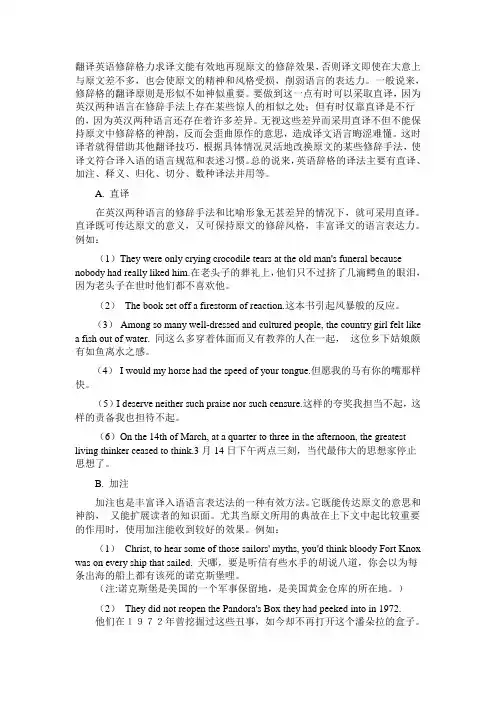
翻译英语修辞格力求译文能有效地再现原文的修辞效果,否则译文即使在大意上与原文差不多,也会使原文的精神和风格受损,削弱语言的表达力。
一般说来,修辞格的翻译原则是形似不如神似重要。
要做到这一点有时可以采取直译,因为英汉两种语言在修辞手法上存在某些惊人的相似之处;但有时仅靠直译是不行的,因为英汉两种语言还存在着许多差异。
无视这些差异而采用直译不但不能保持原文中修辞格的神韵,反而会歪曲原作的意思,造成译文语言晦涩难懂。
这时译者就得借助其他翻译技巧,根据具体情况灵活地改换原文的某些修辞手法,使译文符合译入语的语言规范和表述习惯。
总的说来,英语辞格的译法主要有直译、加注、释义、归化、切分、数种译法并用等。
A. 直译在英汉两种语言的修辞手法和比喻形象无甚差异的情况下,就可采用直译。
直译既可传达原文的意义,又可保持原文的修辞风格,丰富译文的语言表达力。
例如:(1)They were only crying crocodile tears at the old man's funeral because nobody had really liked him.在老头子的葬礼上,他们只不过挤了几滴鳄鱼的眼泪,因为老头子在世时他们都不喜欢他。
(2)The book set off a firestorm of reaction.这本书引起风暴般的反应。
(3)Among so many well-dressed and cultured people, the country girl felt like a fish out of water. 同这么多穿着体面而又有教养的人在一起,这位乡下姑娘颇有如鱼离水之感。
(4)I would my horse had the speed of your tongue.但愿我的马有你的嘴那样快。
(5)I deserve neither such praise nor such censure.这样的夸奖我担当不起,这样的责备我也担待不起。
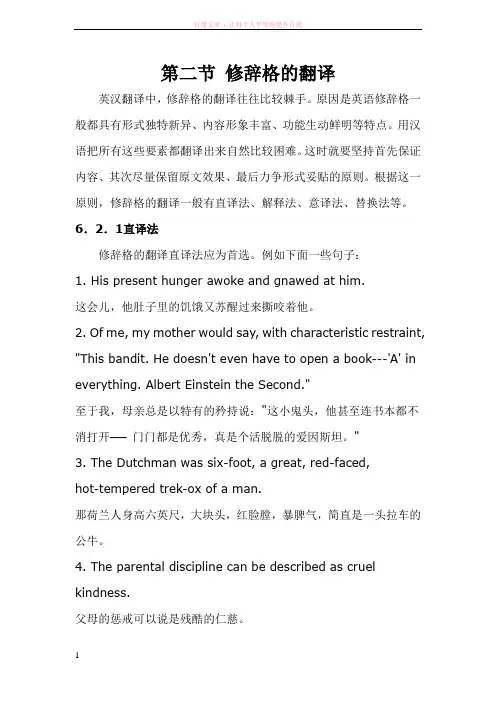
第二节修辞格的翻译英汉翻译中,修辞格的翻译往往比较棘手。
原因是英语修辞格一般都具有形式独特新异、内容形象丰富、功能生动鲜明等特点。
用汉语把所有这些要素都翻译出来自然比较困难。
这时就要坚持首先保证内容、其次尽量保留原文效果、最后力争形式妥贴的原则。
根据这一原则,修辞格的翻译一般有直译法、解释法、意译法、替换法等。
6.2.1直译法修辞格的翻译直译法应为首选。
例如下面一些句子:1. His present hunger awoke and gnawed at him.这会儿,他肚子里的饥饿又苏醒过来撕咬着他。
2. Of me, my mother would say, with characteristic restraint, "This bandit. He doesn't even have to open a book---'A' in everything. Albert Einstein the Second."至于我,母亲总是以特有的矜持说:"这小鬼头,他甚至连书本都不消打开──门门都是优秀,真是个活脱脱的爱因斯坦。
"3. The Dutchman was six-foot, a great, red-faced,hot-tempered trek-ox of a man.那荷兰人身高六英尺,大块头,红脸膛,暴脾气,简直是一头拉车的公牛。
4. The parental discipline can be described as cruel kindness.父母的惩戒可以说是残酷的仁慈。
5. Safety will be the sturdy child of terror, and survival the twin brother of annihilation.安全是恐怖的健壮婴儿,生存是毁灭的孪生兄弟。
6. The plays adapted from Greek tragedies and Shakespearean drama by Suzuki, although performed in Japanese, caused a big stir among the western audience with their strange and cruel beauty.铃木正改编自希腊悲剧和莎士比亚戏剧的剧作,虽然以日语演出,但那种奇异而残酷的美,却在西方观众中引起了轰动。

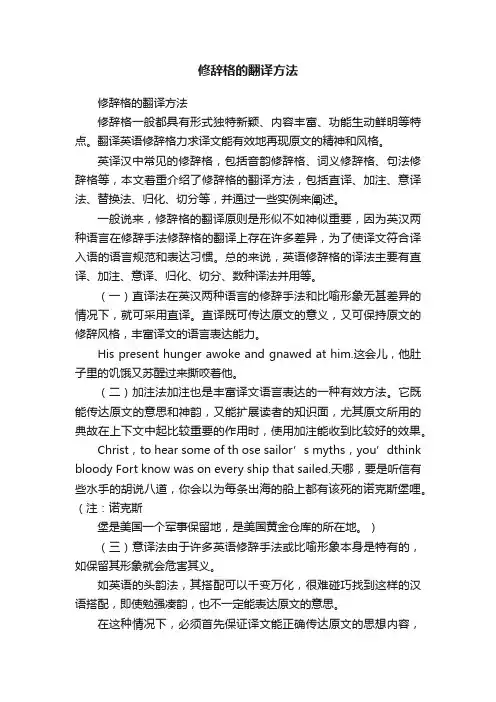
修辞格的翻译方法修辞格的翻译方法修辞格一般都具有形式独特新颖、内容丰富、功能生动鲜明等特点。
翻译英语修辞格力求译文能有效地再现原文的精神和风格。
英译汉中常见的修辞格,包括音韵修辞格、词义修辞格、句法修辞格等,本文着重介绍了修辞格的翻译方法,包括直译、加注、意译法、替换法、归化、切分等,并通过一些实例来阐述。
一般说来,修辞格的翻译原则是形似不如神似重要,因为英汉两种语言在修辞手法修辞格的翻译上存在许多差异,为了使译文符合译入语的语言规范和表达习惯。
总的来说,英语修辞格的译法主要有直译、加注、意译、归化、切分、数种译法并用等。
(一)直译法在英汉两种语言的修辞手法和比喻形象无甚差异的情况下,就可采用直译。
直译既可传达原文的意义,又可保持原文的修辞风格,丰富译文的语言表达能力。
His present hunger awoke and gnawed at him.这会儿,他肚子里的饥饿又苏醒过来撕咬着他。
(二)加注法加注也是丰富译文语言表达的一种有效方法。
它既能传达原文的意思和神韵,又能扩展读者的知识面,尤其原文所用的典故在上下文中起比较重要的作用时,使用加注能收到比较好的效果。
Christ,to hear some of th ose sailor’s myths,you’dthink bloody Fort know was on every ship that sailed.天哪,要是听信有些水手的胡说八道,你会以为每条出海的船上都有该死的诺克斯堡哩。
(注:诺克斯堡是美国一个军事保留地,是美国黄金仓库的所在地。
)(三)意译法由于许多英语修辞手法或比喻形象本身是特有的,如保留其形象就会危害其义。
如英语的头韵法,其搭配可以千变万化,很难碰巧找到这样的汉语搭配,即使勉强凑韵,也不一定能表达原文的意思。
在这种情况下,必须首先保证译文能正确传达原文的思想内容,然后尽一切可能去表现原文的节奏和旋律。
safe and sound安然无恙now and never机不可失(1)He is the mouth of the House in its relations with the crown.他是议会对王室的发言人。
简述英语修辞格的运用及翻译简述英语修辞格的运用及翻译简述修辞格的运用及翻译摘要使用修辞格是为了使语言更加生动形象,鲜明突出,加强语言表现力和感染力。
本文从正确运用英语修辞格及对比分析英汉语言在修辞格式上的异同入手,浅谈如何在忠实表达原文的基础上,正确翻译和理解英语的修辞格,并介绍英语修辞格在翻译方面的基本原则及方法。
关键词英语修辞格翻译运用语言是表达思想的工具,修辞则是语言表达的艺术。
使用修辞格的目的是为了使语言更加生动形象、鲜明突出;或者使语言更加整齐匀称,音调铿锵,加强语言表现力和感染力,引起读者丰富联想的效果。
英语和汉语都有悠久的历史,也都具有非常丰富的修辞方式。
由于东、西方民族文化背景的不同,英汉语言在修辞格式上显然存在着既相一致又有区别的特点。
认识并了解英汉两种语言修辞格式的异同,找出二者各自的特点,有助于我们在英汉语言转换过程中正确理解原文的修辞手法,并在译文中正确使用,从而忠实地表达原文的思想和风格。
以下举例浅谈英语修辞格在翻译方面的基本原则及方法:一、直译法对于英汉两种语言中相类似的常用修辞格,~I1:simile(明喻),metaphor(隐喻),metonym(借代),personification(拟人),hyperbole(夸张),irony(反语),pun(双关),rhetoricquestion(设问)等。
在翻译中当然应当尽可能采用直译的方法,即在用词和修辞结构上都与原文保持一致,做到形神皆似。
举例如下:In his dream he saw the tiny figure fall as a fly(simile)在他的梦中他看见那小小的人影像苍蝇一般地落了下来。
Life is an isthmus between two eternities.(Metaphor)是永恒的生死两端之间的峡道。
Sometimes the pen may be mightier than the sword.(Metonymy)有时文人比武士更有力量。
第九章英语修辞格的译法(教学安排:2课时)修辞格(figure of speech)是提高语言表达效果的语言艺术。
它能使语言生动形象、具体活泼,给人以美的享受。
要翻译好英语修辞格,首先要弄清其特点、弄清英汉两种语言在这方面的异同,然后根据具体情况采用恰当的技巧进行翻译。
翻译英语修辞格力求译文能有效地再现原文的修辞效果,否则译文即使在大意上与原文差不多,也会使原文的精神和风格受损,削弱语言的表达力。
一般说来,修辞格的翻译原则是形似不如神似重要。
要做到这一点有时可以采取直译,因为英汉两种语言在修辞手法上存在某些惊人的相似之处;但有时仅靠直译是不行的,因为英汉两种语言还存在着许多差异。
无视这些差异而采用直译不但不能保持原文中修辞格的神韵,反而会歪曲原作的意思,造成译文语言晦涩难懂。
这时译者就得借助其他翻译技巧,根据具体情况灵活地改换原文的某些修辞手法,使译文符合译入语的语言规范和表述习惯。
大致说来修辞格的翻译法有三:直译法、意译法和直译加注法。
但是,不管采用什么方法,都应尽量保留原修辞格的语言文化特色,努力传递出各种辞格的结构美、意韵美和音韵美。
一、Simile(明喻)simile与汉语的明喻基本相同,用某一事物或情境来比拟另一个事物或情境,使其变抽象为具体、化深奥为浅显、化陌生为熟悉,使描写更加生动形象。
英语simile 的比喻词一般是like, as(……as)等, 汉语明喻的比喻词通常是“好像”、“仿佛”、“一样”、“犹如”、“若”、“似”等。
例如:例1原文:They are like streetcars running contentedly on their rails.译文:1.直译当英语和汉语明喻中的喻义和喻体相对应时,可以采取直译。
例2原文:Among so many well-dressed and cultured people, the country girl felt like a fish out of water.译文:例3原文:Mrs. Macbeth has a heart as hard as flint.译文:例4原文:Previously, if I had been really interested in a book, I would race from page to page, eager to know what came next. Now, I decide, I had to become a miser with words and stretch every sentence like a poor man spending his last dollar.译文:例5as cold as ice as light as feather as bold as a lionas rapid as lightening as hungry as a wolf applause like thundersas sly as a fox as slow as a turtle as busy as a bee as dirty and greedy as a pig 2.改变喻体当英汉明喻中的喻义相同而喻体不同时,翻译时需要改变喻体。
第五章修辞格的翻译方法研究汉英修辞格之间的比较与翻译,对我们进一步研究汉英两种修辞学和英汉互译,尤其是文学翻译,都有着十分积极的意义.原文作者在文章中使用修辞手法,是为了使语言更加形象生动,鲜明突出;或者使语言更加整齐匀称,音调铿锵,以便更深入地阐明事件的意义或刻画人物的性格。
因此,译文中若不能正确表现原文的修辞格,就不能准确地表达作者的思想和文风,就不符合“忠实、通顺”的翻译标准。
为了对原文保持最大限度的忠实,我们对任何一种修辞都要采取一定的处理方法,尽一切可能把原文的修辞美传达给译文读者。
从翻译的角度,修辞可以划分为三类:可译、难译、不能译。
首先,对于可译的修辞格,尽可能直译.属于直译范围的修辞格是我们平时使用最为频繁的,在汉英两种语言里都有对应的修辞格,这类修辞格通常在在语义上做文章,因而容易翻译。
绝大多数英语修辞格都能找到与之相对应的汉语修辞格,它们在结构上和修辞作用上都彼此十分相似,因而是可译的。
一、可译:直译1. Simile, Metaphor, Hyperbole and personificationSimile 明喻英语中的simile和汉语明喻基本格式相同,本体和喻体之间都出现喻词“像、好像、比如、仿佛、好比、像…一样、如…一般”或“Like, as, as if, as though,as…as”,所以一般情况下,可以照直翻译。
比如:“as busy as bee,as brave as lion, as cheerful as a lark,as black as crow,as sharp as knife”.Example 1:她的脸色苍白而带光泽,仿佛大理石似的;一双眼睛又黑又大,在暗淡的囚房中,宝石似的闪着晶莹的光.(杨沫,《青春之歌》)Her face was pale and yet as lustrous as marble, and her large, black eyes sparkled like jewels in that murky cell。
第五章修辞格的翻译方法研究汉英修辞格之间的比较与翻译,对我们进一步研究汉英两种修辞学和英汉互译,尤其是文学翻译,都有着十分积极的意义。
原文作者在文章中使用修辞手法,是为了使语言更加形象生动,鲜明突出;或者使语言更加整齐匀称,音调铿锵,以便更深入地阐明事件的意义或刻画人物的性格。
因此,译文中若不能正确表现原文的修辞格,就不能准确地表达作者的思想和文风,就不符合“忠实、通顺”的翻译标准。
为了对原文保持最大限度的忠实,我们对任何一种修辞都要采取一定的处理方法,尽一切可能把原文的修辞美传达给译文读者。
从翻译的角度,修辞可以划分为三类:可译、难译、不能译。
首先,对于可译的修辞格,尽可能直译。
属于直译范围的修辞格是我们平时使用最为频繁的,在汉英两种语言里都有对应的修辞格,这类修辞格通常在在语义上做文章,因而容易翻译。
绝大多数英语修辞格都能找到与之相对应的汉语修辞格,它们在结构上和修辞作用上都彼此十分相似,因而是可译的。
一、可译:直译1. Simile, Metaphor, Hyperbole and personificationSimile 明喻英语中的simile和汉语明喻基本格式相同,本体和喻体之间都出现喻词“像、好像、比如、仿佛、好比、像…一样、如…一般”或“Like, as, as if, as though, as…as”,所以一般情况下,可以照直翻译。
比如:“as busy as bee,as brave as lion,as cheerful as alark,as black as crow,as sharp as knife”。
Example 1:她的脸色苍白而带光泽,仿佛大理石似的;一双眼睛又黑又大,在暗淡的囚房中,宝石似的闪着晶莹的光。
(杨沫,《青春之歌》)Her face was pale and yet as lustrous as marble, and her large, black eyes sparkled like jewels in that murky cell.但是由于文化差异导致某些喻体联想意义的不同,因而不能墨守原文的修辞手法,比如“As cool as a cucumber,As sharp as a needle,As tight as a drum,As sure as a gun”。
Metaphor (隐喻) 英汉暗喻都不露比喻痕迹,把“甲”直接说成是“乙”或变成了“乙”。
常用的词有“是、变成、变为、成为、成了、当作”或者“Be, become, turn into”Example 2:Passion was to go to sleep in the presence of Mrs. General and blood was to change to milk and water. (Dickens. Little Dorrit)在杰纳勒尔夫人跟前,一个人的激情会变得麻木不仁,热血也会变成掺了水的牛奶。
Example 3:何等动人的一页又一页篇章!这是人类思维的花朵。
(徐迟,《哥德巴赫猜想》)What inspiring chapters! They are the flowers of the human brainwork.Hyperbole (夸张) 有意夸大或缩小事物的某一方面,从而获得更好的表达效果,英汉中都常常用到,可以直译。
Example 4:突然,在我们头顶五六丈的上空,发出一声可怕的霹雳,闪电像利剑一样直插下来,天空被彻底吹裂了,震碎了!(叶蔚林,《在没有航标的河流上》)All of a sudden, there came a terrible thunder-clap about fifty feet directly above our heads, and a blot thrust downward like a sharp sword. The sky was brought into pieces.Personification (拟人) 把人以外无生命之物或有生命之物当作人来写。
Example 5:“Don‟t talk to me about no opportunity anymore. Opportunity‟s knocking down every door in the country, trying to get in. When I was young, a man had to go out and find opportunity and drag it home by the ears.” (Kurt V onnegut, Tom Edison‟s Shaggy Dog)“休说什么机会难逢。
机会正在国内每家每户敲门,想要进去呢。
我年轻那会儿,人们得出门去寻找机会,揪着耳朵把它拖回来。
2. Euphemism, Metonymy, Ellipsis and PeriphrasisEuphemism(委婉语) 用委婉词来回避令人不愉快的词句,英语和汉语里都有,可以直译。
Example 6:尤氏道:“我也暗暗地叫人预备了。
——就是那件东西,不得好木头,且慢慢地办着罢。
”(曹雪芹,《红楼梦》,第十一回)“I‟ve secretly sent people to get things prepared. But they haven‟t found good wood for that thing yet, so we have to wait.”Example 7:His daughter is rather weak in the head.他女儿脑子不太好使。
Metonymy一般分三种:借人或事物的特征或标志来代指人或事物;借人或事物有关的工具或材料代指人或事物;借与人或事物有关的所属或所在歹势人或事物。
英汉语中都有这一修辞手法,可以直译。
Example 8:秃头站在白背心的略略正对面,弯了腰,去研究背心上的文字。
(鲁迅,《示众》)Baldy, standing almost directly opposite White Jerkin, stooped to study the characters written on his jerkin.Example 9:Paper and ink cut the throats of men, and sound of a breath may shake the world.纸墨能割断人的喉咙,嗓音能震动整个世界。
但由于英汉两种语言不同的习惯表达方法,有时意译更为合适:比如“Great minds think alike”译成“英雄所见略同”,把“Grey hair should be respected”译成“老年人应受到尊敬”。
Ellipsis(省略) 英汉语里都有,且运用上没什么差别(一般出现在口语体和非正式文体中),可以直译。
Example 10:“When did he say this?”“At the playground. And walking home. Yesterday.”“他什么时候说这话的?”“在广场上。
昨天回家的路上。
”但要注意英语里另一种省略形式—Asyndeton(连词省略)比如,“They smiled, shook hands, parted.”可以译成“他们微微一笑,相互握手,分手告别。
”Periphrasis(折绕) 有话不直说,却故意绕个弯子,用迂回曲折的话来代替的一种修辞方式。
Example 11:“孔乙己,你脸色又添上新伤疤了!”(鲁迅《孔乙己》)“Kong YIji! You‟ve got fresh scars on your face!”Example 12:His olfactory system was suffering from a temporary inconvenience.她的嗅觉系统暂时有些不便。
3. Hypallage, irony, parallelismHypallage,transferred epithet (移就):把本来用以修饰人的形容词移属于与人有关的抽象物或具体物,这种貌似错误、实为妙用的修辞格就叫移就。
这一词格在英汉两种语言里都有,一般能直译,见下例:Example 15:然而悲惨的皱纹,却也从他的眉头和嘴角出现了(《鲁迅全集》)。
Miserable wrinkles began to appear between his eye-brows and round his mouth.Irony(反语) 使用同本意完全相反的词句来表达本意,明显含有嘲弄讽刺的意义,从而使本体更加突出。
Example 15:根据报纸上官方介绍,他是天底下头等大好人,浑身上下毫无缺点,连肚脐眼都没有(宗福先《于无声处》)。
According to the official write-up in the papers, he‟s the best man in the world. He doesn‟t have a single defect in his whole body. Why, he doesn‟t even have a belly-button!Parallelism(排比)Example 16:The seed you sow, another keeps; 你播撒的种子,别人收;The wealth you find, another keeps; 你发现的财富,别人留;The robes you weave, another wears; 你编织的衣服,别人穿;The arms you forge, another bears. 你铸造的武器,别人用。
二、难译:意译直译法仅限于在用词和修辞结构上与原文一致情况下使用。
由于英汉两个民族的历史沿革、风俗习惯和思维方式各不相同。
在这种情况下,就需要采用意译。
我们可以通过增加词语、引申词意、转换修辞格或转换比喻形象等方法来确切地表达原文修辞格所表现的感染力。
此外,还有不少修辞是利用各自语言的特点而形成的,无法直译,只好改换意译,将原文的内涵再现出来。
析数:利用数字相乘或相加,把一个大数拆成若干个小数来说。
英语里物此固定的修辞,因而翻译难度较大,但是有些还是可以直译的,比如例17.Example 17: 阿舒已二八,懒惰故无匹。
(陶渊明《责子》)A-shu is twice eight, For laziness he has no equal.Example 18: 三五中秋夕,清游拟上元。